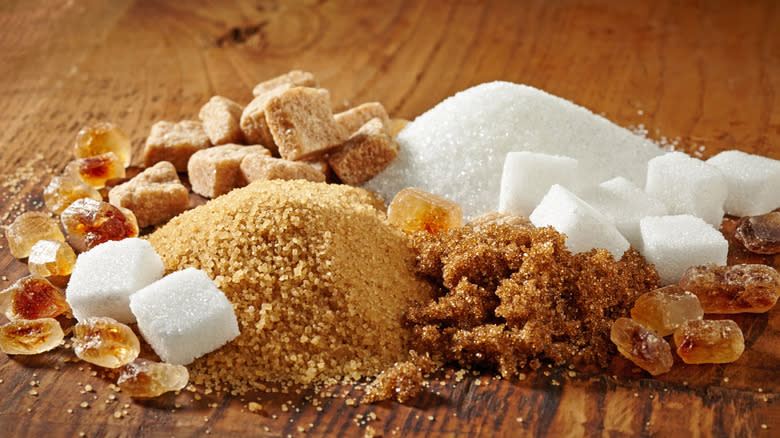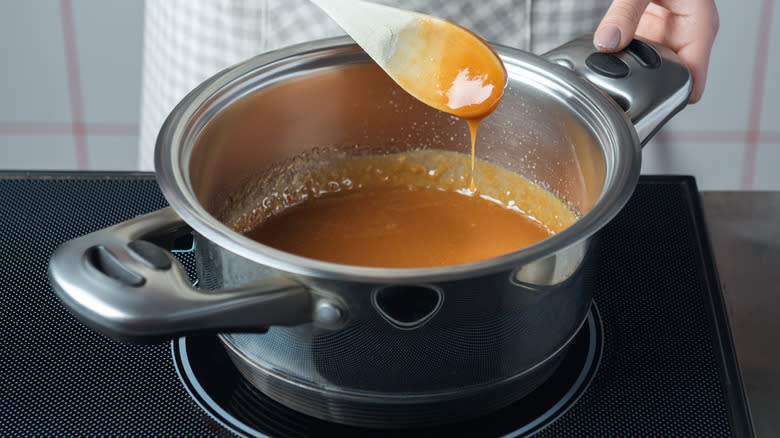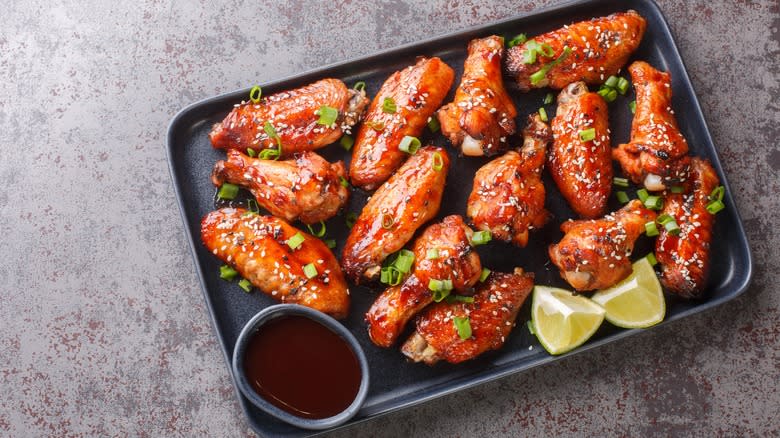Everything You Need To Know About Brown Sugar

When it comes to enhancing our food and drink with a little sweetness, there's a huge variety of different sugars out there to choose from. From classic white granulated sugar to unrefined coconut and artisan sucanat sugars, each variety brings its own unique flavor and texture to our kitchen creations. But today, we're focusing on an extremely popular form of sugar, with a rich taste and wonderful golden hue. You guessed it — brown sugar. It's a kitchen staple for many of us, but this versatile ingredient also possesses a range of fascinating characteristics.
Brown sugar is incredibly popular in the world of baking. It comes on various forms, which feature in cookie, cake, brownie, and bread recipes amongst others. Being rich in molasses, brown sugar can impart a deep caramel flavor and moist texture, that many baked goods simply wouldn't work without. But its uses also extend beyond sweet recipes, and even to outside of the kitchen, with it often being used to make natural cosmetic products, too.
But what makes brown sugar unique? Well, we're covering everything you need to know about this pantry staple, from the reasoning behind its rich golden color, to the best ways you can use it at home. We'll explore its history, its nutritional value, and even share a handy tip for reviving a hardened packet of sugar. So, if you want to learn more about this versatile sweetener, you're in the right place.
Read more: 16 Little-Known Facts About Salt
There Are Multiple Varieties Of Brown Sugar

The term "brown sugar" actually encompasses several types of sugar, each with its own distinct characteristics. The two main types of brown sugar are light brown sugar and dark brown sugar, which can be differentiated by their molasses content.
Light brown sugar has the milder flavor of the two, with a subtle caramel taste and a moist, dense texture. It contains about 3% molasses, giving it a light golden color. Light brown sugar is often the go-to sweetener for baking cookies and cakes, since its flavor enhances baked goods without overpowering other ingredients.
On the other hand, dark brown sugar has a stronger flavor due to its higher molasses content, typically around 7%. This results in a deeper color and a richer toffee-like flavor. It can add a real depth to your recipes, working brilliantly paired with warm spices in bakes like gingerbread cookies, and even in savory marinades and sauces for meats.
There are also a range of specialty brown sugars, such as demerara and muscovado. Again, these all come with unique flavors and characteristics. Demerara sugar has large, golden crystals and a subtle molasses flavor, making it perfect for sprinkling on top of freshly baked cakes or rolling cookie dough balls in before baking. Muscovado sugar is much darker, very moist, and sticky in texture, with a strong molasses taste perfect for flavoring sweet treats like chocolate brownies and sticky toffee pudding.
It Has A Richer Flavor Than White Sugar

The rich, caramel flavor of brown sugar is undeniable, and this is what sets it apart from its more mildly flavored counterpart — white sugar. The key difference between these two sugar varieties is the molasses content.
In the process of making white sugar, all of the natural molasses is removed. This leaves it with a delicate sweetness that doesn't interfere with the flavor of the recipes it features in. White sugar is incredibly versatile and probably the type of sweetener many of us reach for most in our kitchens.
Molasses has a deep, almost smoky, caramel-like taste, which infuses brown sugar with a unique depth of flavor that white sugar simply lacks. As molasses is reintroduced into the sugar crystals, it adds a delicious richness, and the distinct flavor notes will differ depending on the variety of brown sugar you opt for.
Most Brown Sugar Starts As White Sugar

It's a common misconception that all brown sugar is less refined and more natural than white sugar. In fact, many types of brown sugar actually begin their journey as plain old white sugar. The light and dark brown sugars most widely available in grocery stores have been made by adding molasses back in to white sugar to give it varying degrees of color and flavor. Molasses is a natural byproduct that comes from the sugar cane or sugar beets used in the sugar production process. It's thick, dark, and syrupy, and a potent tool for adding heaps of caramel flavor to sugar.
You can even make your own brown sugar at home by combining white sugar with a little store-bought molasses. The amount of molasses added will depend on whether you are aiming to create light or dark brown sugar. Using an electric mixer would also be your best bet to ensure even distribution of the molasses throughout the sugar crystals.
Some Types Of Brown Sugar Are Unrefined

Whilst many types of brown sugar are produced by blending refined white sugar with molasses, some varieties can be classed as unrefined. Refined sugars, like most light and dark brown varieties, have undergone extensive processing to remove impurities, as well as centrifugation to separate the sugar crystals from the molasses (yes, even when molasses has been added back in again later!). However, unrefined brown sugars have a much more pared back production process, where the natural molasses content is preserved. Extracts of the sugar cane are simply heated to evaporate off the liquid, and the resulting sugar crystals are naturally dark in color and packed with that sweet molasses taste.
Unrefined brown sugars typically boast a molasses content of between eight to 14 percent. Some varieties to look out for include muscovado, sucanat, and jaggery, which typically have coarser crystals and a rich flavor. These are often deemed more premium forms of sugar, with their simplified production process suggesting a more natural and nutritious product. However, whilst unrefined sugars do have an extremely slight edge on their refined counterparts when it comes to nutrient content, the difference is not at all significant. Ultimately, whether it's heavily processed or not, eating excess sugar can lead to health problems, and we should enjoy either form in moderation.
It Makes Baked Goods More Moist

One reason that brown sugar is so popular amongst bakers is its ability to add moisture to baked goods, giving us soft, tender, and flavorful treats. And again, its mighty molasses that gives brown sugar this characteristic.
Molasses is hygroscopic, which means it absorbs and holds on to lots of moisture. So, when using brown sugar in your bakes, it should result in a moister, slightly denser texture than white sugar would. Light brown sugar is renowned for giving chocolate chip cookies the ultimate chewiness, and it's also popular in chocolate brownie recipes where we want a dense, fudgy result.
The presence of molasses also makes brown sugar more acidic than white sugar. Baking soda, a popular ingredients in cakes and cookies, requires activation by an acid, so brown sugar also helps in the leavening department. You'll find that brown sugars help baking soda-leavened treats to rise higher or spread out wider. The higher the molasses content in your sugar, the greater the impact it will have.
It's Actually Not The Best Type Of Sugar For Making Caramel

Using brown sugar is the perfect way to sweeten a whole host of recipes, and when it comes to making caramel, you might think its delicious molasses flavor would make it a natural choice. However, brown sugar isn't actually the best option here.
Whilst brown sugar has many beneficial characteristics, its molasses content means it can contain more impurities than white sugar. This can interfere with the caramelization process, which is key for making caramel, and makes it more likely that the sugar will burn before it gets to the caramelized stage.
Furthermore, caramel cooks very quickly, and needs close monitoring to look out the that crucial color change to the rich, deep amber shade that indicates it's ready. Since brown sugar is already darker in color than white sugar, it makes it much harder to keep track of the browning process and know when its reached the ideal color. Therefore, white granulated sugar or caster sugar are typically the preferred choices for homemade caramel. But if you're simply making a caramel-flavored sauce or want to add more richness to a glaze, brown sugar can still be a wonderful option.
It's Slightly Higher In Nutrients Than White Sugar

As we've learned, brown sugar is often simply just white sugar with the addition of molasses. But how does this affect its nutrient make-up? Well, the answer is not by very much. Yes, brown sugar does retain slightly greater amounts of certain nutrients than white sugar, but really the difference is negligible.
Molasses contains small amounts of minerals like calcium, iron, and potassium, and when we look at the brown sugar as a whole, these become meager trace amounts. Brown sugar also contains marginally less calories (15 calories per teaspoon) than white sugar (16.3 calories per teaspoon). Clearly, the figures don't present enough of a reason to warrant choosing brown over white. Put simply, as delicious as it is, no type of sugar can be classed as a good source of nutrients. So, when it comes to choosing white or brown sugar, consider the effect it will have on the flavor and texture of your recipe rather than any health benefits.
You Can Use It In Savory Recipes, Too

If you've only reached for brown sugar when baking sweet treats, you're missing out! As fantastic as it is for sweetening cakes and cookies, there are plenty of other ways you can use brown sugar to enhance your cooking. Its rich flavor and subtle sweetness also make it a versatile ingredient for use in savory recipes.
Firstly, many marinades and meat glazes can benefit from the sweet caramel flavor of brown sugar, which helps to balance out the savory richness of the rest of the dish. Try roasting chicken in a sweet and spicy sauce made with brown sugar, butter, and sriracha, or glazing pork chops in a moreish mixture of brown sugar, soy sauce, apple cider vinegar, and mustard.
Brown sugar is also a popular ingredient in Asian-inspired stir-fry dishes, where it balances perfectly with aromatics like garlic and ginger, as well as umami-rich and tangy ingredients like soy sauce and rice vinegar. Not only does it add sweetness, it can also introduce a mouthwatering sticky texture to the stir-fry sauce. If you're a fan of pickling, brown sugar also comes in handy here. When preparing pickled veggies, this trusty sweetener can be added to the pickling liquid. Its sweetness makes a lovely contrast against the acidic nature of the vinegar, and enhances the taste of other herbs and spices in the liquid.
You Can Revive Hardened Brown Sugar With A Slice Of Bread

Have you ever grabbed your brown sugar from the pantry, only to find it's hardened into one big clump? When moisture evaporates from the molasses in brown sugar, it can cause the sugar crystals to stick together, making it impossible to scoop and measure.
Thankfully, there's a handy trick that can revive your hardened brown sugar, requiring nothing but a simple slice of bread. If your sugar is in a large jar or bag with enough space, pop the bread slice into the container and seal it up. Or you can remove the hardened sugar from the container it's in and transfer it to a resealable food bag along with the bread. Just seal it up and let it sit overnight so the bread can work its magic.
The bread will help to soften everything up, with moisture leaching from the bread into the sugar. Once the brown sugar is softened, you'll find that the bread is hard since it's now devoid of moisture! You should be able to break apart any remaining clumps in your sugar with a fork and scoop with ease.
Brown Sugar And White Sugar Aren't Always Interchangeable

Brown and white sugars can both bring plenty of sweetness to your recipes, but you shouldn't assume that the two are entirely interchangeable. For example, in bakes like cookies and cakes, a recipe will usually specify that either white or brown sugar should be used, and this is for good reason.
Sure, if you swap one type of sugar for another, your bake probably won't fail completely. But the intended texture and flavor may not quite live up to expectation. White sugar is often key in recipes aiming for a subtle flavor and light, fluffy texture, like an angel food cake. On the other hand, brown sugar brings moisture to quick breads and chewiness to cookies. Many chocolate chip cookie recipes actually suggest using a mixture of white and brown sugar. The brown sugar helps the cookies to spread and rise whilst adding color and flavor, and giving them that signature chewy texture. The white sugar is equally as important, preventing the cookies from browning too much and helping the outer layer to stay nice and crisp.
So, while switching these two sugars isn't a complete disaster, you will notice that each gives different results. To ensure your bakes come out just right, it's generally best to stick to the guidance in your specific recipe.
Its Origins Date Back To The 1700s

The history of brown sugar dates back centuries, with its origins rooted in the sugar trade of the 1700s. First produced in the West Indies, some brown sugar was made through the process still commonly used today, by combining refined white sugar with molasses. Unrefined brown sugars like muscovado were also made by boiling sugar cane juice and leaving it to crystallize. At this point, white sugar was already being produced on a large scale, with many sugar plantations established across the islands.
Producing sugar required a huge amount of exhausting manual labor, and sadly the early sugar industry has strong ties with the slave trade. Many people were brought to the West Indies from Africa, enslaved, and forced to work on plantations. They faced grueling work and poor treatment, and many people died within just a few years working on the plantations.
But the demand for brown sugar only continued to grow. It gained popularity in Europe and North America since it was a much more affordable alternative to white sugar. Today, its rich flavor and versatility makes it a staple in kitchens around the world, where its used in everything from baked goods to savory dishes and beverages.
Its Uses Extend Beyond The Kitchen

Brown sugar is a trusty sweetener that takes pride of place in many pantries across the world. But its uses can also extend beyond the kitchen and into various other areas of daily life. A common and non-food related use for brown sugar is as an ingredient in DIY beauty treatments. Due to its natural exfoliating properties and moisturizing effects, brown sugar is often a key component of scrubs and masks that work to gently remove dead skin cells, leaving the skin soft and smooth. One simple homemade scrub idea is to combine brown sugar and coconut oil, plus any essential oils of choice for an added scent boost.
Brown sugar also features in some natural remedies for treating certain ailments. When mixed with warm water, lemon, and honey it can be used as a soothing way to alleviate sore throats and coughs. This is because the sugar acts as a demulcent, which means it's able to form a protective coating over the irritated areas of the throat.This sweetener is also popular in the world of crafts, where it can be used to make everything from candles to bubble mixture. It's also a common addition to homemade festive potpourri.
Read the original article on Mashed


